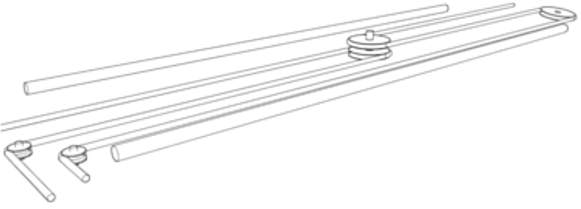
Building a 3d model on rhino5 of an axis head to run some tests
A longtime ago I’ve learned rhino at school and that’s the reason I used it for these task.
First I started by drawing a circle , than using offset curve
, than using offset curve I drew more concentric circles that I copied to a certain distance, by making a line
I drew more concentric circles that I copied to a certain distance, by making a line  and using mirror
and using mirror  in the mid point of that line. From there i made more horizontal and vertical lines using some of the above tools, and used trim
in the mid point of that line. From there i made more horizontal and vertical lines using some of the above tools, and used trim  to take out the some parts off the lines leaving behind just some out lines do extrude my model.
to take out the some parts off the lines leaving behind just some out lines do extrude my model.
Press Fit
I started my press fit task based on a triangle as base material I used some old 3mm acrylic from a store front.
2nd - some basic ideas I already have in mind…( at this point everything is changeable):
Motors - I intend to use dc motors for many reasons, the 1st one being they are more common, then it's easier to buy a used powerful one. And, as I recovered many encoders from hp printers, I can get the proper positioning feedback I need; and the 2nd reason is that I'm going to learn how to read and control input and output devices, nothing better than combine them both on my final project. With hi-torque, both stopped and in motion, good gear reduction, hi-durability and being available as cheap used parts, I found car window and windscreen wiper motors to be apparently ideal for my project…
Global idea
Let's a build cnc milling machine
1st - what do I intend it to be:
Number of axis – in my working area I need one with at least 4, obviously 5 would be great. If you are looking to design one yourself I advise you to start with the pictures on this webpage. They give you a good idea of almost all the possible machine configurations as well as the name usually used to define the axis http://www.cnc-toolkit.com/support.
htmlFast – yes but I will happily give up on speed to increase precision and accuracy-Precise and Accurate – yes as much as can build it, they are the most relevant features in my projected Heavy-duty – of corse it would be great to build an all-in-one but I will mill mostly lost wax, so let's see what I can do…
4th and 5th axis working angle - these are for me the 2nd on the most important features.
x-y working area - not too big, desk top size as I do not intend to mill nothing bigger than A4, but with enough space to accommodate a permanent 5th axis
2nd - some basic ideas I already have in mind…( at this point everything is changeable):
Motors - I intend to use dc motors for many reasons, the 1st one being they are more common, then it's easier to buy a used powerful one. And, as I recovered many encoders from hp printers, I can get the proper positioning feedback I need; and the 2nd reason is that I'm going to learn how to read and control input and output devices, nothing better than combine them both on my final project. With hi-torque, both stopped and in motion, good gear reduction, hi-durability and being available as cheap used parts, I found car window and windscreen wiper motors to be apparently ideal for my project…

Encoders - as I said I already have many from old printers and, as I have so many of them, I'm planning to use 2 encoders for each x, y and z axis, one linear in the axis and one radial in the motor to precise positioning between the steps of the 1st one, with the aim of getting more velocity without losing precision.
Linear actuators - after extensive search of machines and building methods I decided that the best relation cost\easy building\accuracy was the one used in mdx – 20 where the axis are actuated by steel cable, for that it became the one I intend to use. I also intend to make same tests to see if it can use Bowden cable ( http://en.wikipedia.org/wiki/Bowden_cable ) to take the motors away from the axis reducing their weight and inertia, without losing accuracy and for how many Newtons that is true...

see https://drive.google.com/folderview?id=0B-zSpF8Sy3QLM0pIZmw4c1lRb1k&usp=sharing for files
see https://drive.google.com/folderview?id=0B-zSpF8Sy3QLM0pIZmw4c1lRb1k&usp=sharing for files
Guilherme Moreira | 18-01-2014 | 04:46 AM | Lisboa | Portugal | para Fab Academy 2014 (pt)